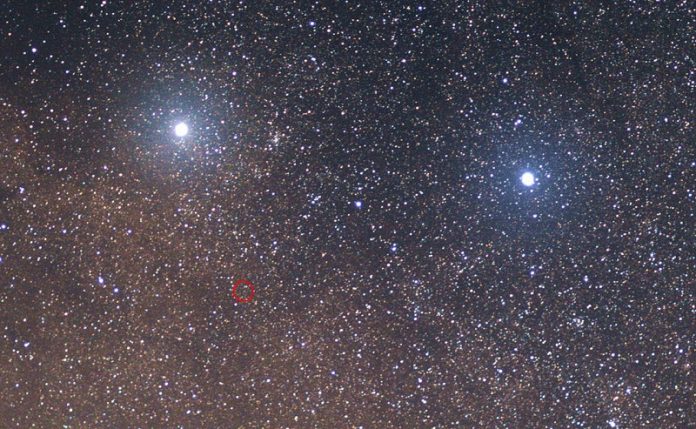
Proxima Centauri is the closest star to the Sun, and its planet, Proxima Cen b (“Proxima b”), lies in its habitable zone.
This makes the planet a prime target for exoplanet characterization.
The star is an M- dwarf with a mass of only 0.12 solar-masses and an effective surface temperature of about 3000 kelvin.
The comparatively low surface temperature means that its habitable zone lies very close to the star and Proxima b, with its mass of about 1.2 Earth-masses, lies about twenty times closer to the star than the Earth does to the Sun, orbiting in only 11.2 days.
Being as close as it is to its star, Proxima b (like all habitable-zone exoplanets around M-dwarf stars) is susceptible to stellar flares, winds, X-rays, and other kinds of activity that could disrupt its atmosphere and possibilities for life.
These activities are linked to the strong magnetic fields in M-dwarfs, and they remain active in dwarf stars over much longer timescales than in higher-mass stars like the Sun, so that the cumulative exposures are commensurately greater.
All these issues have been investigated in some detail for Proxima b; one conclusion, for example, is that it is probably subject to wind pressures ten thousand times larger than those exertred bu the Sun on the Earth.
A new planet has recently been discovered in the Proxima Cen system, Proxima c, after astronomers spotted slight variations in the orbital velocity of Proxima b (because it does not transit the star, its discovery was made by monitoring its velocity, not the star’s lightcurve).
Followup studies of Proxima c determined that it was a ~ six Earth-mass planet and orbited at 1.44 AU every 5.3 years – and is much farther away from the star than Proxima b. (There are even hints of the presence of a third planet).
CfA astronomers Jeremy Drake and Cecilia Garraffo, and their colleagues, investigated the effects the star’s activity might have on Proxima c’s atmosphere.
The scientists constructed the most comprehensive numerical simulation of the space environment of the Proxima Cen system that has been done to date including models for the stellar corona and realistic surface magnetic field configurations during the minimum and maximum activity states of the star.
Their results indicate that Proxima c experiences Earth-like conditions, at least in terms of stellar wind effects.
It is not known whether or not Proxima c actually has an atmosphere, but the new models indicate the conditions are not unduly corrosive and are favorable for the persistence of any atmosphere that does exist.



